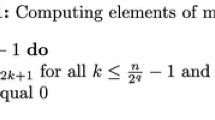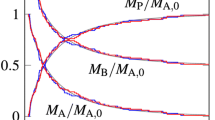Abstract
Stochastic reaction–diffusion models have become an important tool in studying how both noise in the chemical reaction process and the spatial movement of molecules influences the behavior of biological systems. There are two primary spatially-continuous models that have been used in recent studies: the diffusion limited reaction model of Smoluchowski, and a second approach popularized by Doi. Both models treat molecules as points undergoing Brownian motion. The former represents chemical reactions between two reactants through the use of reactive boundary conditions, with two molecules reacting instantly upon reaching a fixed separation (called the reaction-radius). The Doi model uses reaction potentials, whereby two molecules react with a fixed probability per unit time, λ, when separated by less than the reaction radius. In this work, we study the rigorous relationship between the two models. For the special case of a protein diffusing to a fixed DNA binding site, we prove that the solution to the Doi model converges to the solution of the Smoluchowski model as λ→∞, with a rigorous \(O(\lambda^{-\frac{1}{2} + \epsilon})\) error bound (for any fixed ϵ>0). We investigate by numerical simulation, for biologically relevant parameter values, the difference between the solutions and associated reaction time statistics of the two models. As the reaction-radius is decreased, for sufficiently large but fixed values of λ, these differences are found to increase like the inverse of the binding radius.



Similar content being viewed by others
References
Andrews, S. S., & Bray, D. (2004). Stochastic simulation of chemical reactions with spatial resolution and single molecule detail. Phys. Biol., 1, 137–151.
BelHadjAli, H., Amor, A. B., & Brasche, J. F. (2011). Large coupling convergence: overview and new results. In M. Demuth, B. W. Schulze, & I. Witt (Eds.), Operator theory: advances and applications: Vol. 211. Partial differential equations and spectral theory (pp. 73–117). Basel: Springer.
Demuth, M. (1980). On scattering of diffusion process generators. Lett. Math. Phys., 4(5), 417–424.
Demuth, M., Jeske, F., & Kirsch, W. (1993). Rate of convergence for large coupling limits by Brownian motion. Ann. Inst. Henri Poincaré, a Phys. Théor., 59(3), 327–355.
Doi, M. (1976a). Second quantization representation for classical many-particle system. J. Phys. A, Math. Gen., 9(9), 1465–1477.
Doi, M. (1976b). Stochastic theory of diffusion-controlled reaction. J. Phys. A, Math. Gen., 9(9), 1479–1495.
Donev, A., Bulatov, V. V., Oppelstrup, T., Gilmer, G. H., Sadigh, B., & Kalos, M. H. (2010). A first-passage kinetic Monte Carlo algorithm for complex diffusion–reaction systems. J. Comp. Physiol., 229(9), 3214–3236.
Drawert, B., Engblom, S., & Hellander, A. (2012). URDME: a modular framework for stochastic simulation of reaction-transport processes in complex geometries. BMC Syst. Biol., 6(1), 76.
Dushek, O., van der Merwe, P. A., & Shahrezaei, V. (2011). Ultrasensitivity in multisite phosphorylation of membrane-anchored proteins. Biophys. J., 100(5), 1189–1197.
Elf, J., & Ehrenberg, M. (2004). Spontaneous separation of bi-stable biochemical systems into spatial domains of opposite phases. IET Syst. Biol., 1(2), 230–236.
Erban, R., & Chapman, S. J. (2009). Stochastic modelling of reaction–diffusion processes: algorithms for bimolecular reactions. Phys. Biol., 6(4), 046001.
Erban, R., Chapman, S. J., & Maini, P. K. (2007). A practical guide to stochastic simulations of reaction-diffusion processes. arXiv:0704.1908 [q-bio.SC].
Fange, D., Berg, O. G., Sjöberg, P., & Elf, J. (2010). Stochastic reaction–diffusion kinetics in the microscopic limit. Proc. Natl. Acad. Sci. USA, 107(46), 19820–19825.
Fange, D., Mahmutovic, A., & Elf, J. (2012). MesoRD 1.0: stochastic reaction–diffusion simulations in the microscopic limit. Bioinformatics, 28(23), 3155–3157.
Gardiner, C. W. (1996). Springer series in synergetics: Vol. 13. Handbook of stochastic methods: for physics, chemistry, and the natural sciences (2nd ed.). New York: Springer.
Gardiner, C. W., McNeil, K. J., Walls, D. F., & Matheson, I. S. (1976). Correlations in stochastic models of chemical reactions. J. Stat. Phys., 14, 307.
Gesztesy, F., Gurarie, D., Holder, H., Klaus, M., Sadun, L., Simon, B., & Vogl, P. (1988). Trapping and cascading of eigenvalues in the large coupling limit. Commun. Math. Phys., 118(4), 597–634.
Girsanov, I. V. (1960). The solution of certain boundary problems for parabolic and elliptic equations with discontinuous coefficients. Sov. Math. Dokl., 1, 1373–1375.
Glimm, J., & Jaffe, A. (1987). Quantum physics; a functional integral point of view (2nd ed.). New York: Springer.
Hellander, S., Hellander, A., & Petzold, L. (2012). Reaction–diffusion master equation in the microscopic limit. Phys. Rev. E, 85(4), 042901.
Hepburn, I., Chen, W., Wils, S., & De Schutter, E. (2012). STEPS: efficient simulation of stochastic reaction–diffusion models in realistic morphologies. BMC Syst. Biol., 6(1), 36.
Isaacson, S. A. (2008). Relationship between the reaction–diffusion master equation and particle tracking models. J. Phys. A, Math. Theor., 41(6), 065003.
Isaacson, S. A. (2009). The reaction–diffusion master equation as an asymptotic approximation of diffusion to a small target. SIAM J. Appl. Math., 70(1), 77–111.
Isaacson, S. A. (2012, submitted). A convergent reaction–diffusion master equation. Preprint. arXiv:1211.6772.
Isaacson, S. A., & Isaacson, D. (2009). Reaction–diffusion master equation, diffusion-limited reactions, and singular potentials. Phys. Rev. E, 80(6), 066106.
Isaacson, S. A., McQueen, D. M., & Peskin, C. S. (2011). The influence of volume exclusion by chromatin on the time required to find specific DNA binding sites by diffusion. Proc. Natl. Acad. Sci. USA, 108(9), 3815–3820.
Kang, H.-W., Zheng, L., & Othmer, H. G. (2012). A new method for choosing the computational cell in stochastic reaction–diffusion systems. J. Math. Biol., 65(6–7), 1017–1099.
Keizer, J. (1982). Nonequilibrium statistical thermodynamics and the effect of diffusion on chemical reaction rates. J. Phys. Chem., 86, 5052–5067.
Kerr, R. A., et al. (2008). Fast Monte Carlo simulation methods for biological reaction–diffusion systems in solution and on surfaces. SIAM J. Sci. Comput., 30(6), 3126–3149.
Kühner, F., Costa, L. T., Bisch, P. M., Thalhammer, S., Heckl, W. M., & Gaub, H. E. (2004). LexA-DNA bond strength by single molecule force spectroscopy. Biophys. J., 87, 2683–2690.
Lipkova, J., Zygalakis, K. C., Chapman, S. J., & Erban, R. (2011). Analysis of Brownian Dynamics simulations of reversible bimolecular reactions. SIAM J. Appl. Math., 71(3), 714.
McQuarrie, D. A. (1967). Stochastic approach to chemical kinetics. J. Appl. Probab., 4, 413–478.
Nadkarni, S., Bartol, T. M., Stevens, C. F., Sejnowski, T. J., & Levine, H. (2012). Short-term plasticity constrains spatial organization of a hippocampal presynaptic terminal. Proc. Natl. Acad. Sci. USA, 109(36), 14657–14662.
Olenik, O. A. (1961). Boundary-value problems for linear elliptic and parabolic equations with discontinuous coefficients. Izv. Akad. Nauk SSSR, Ser. Mat., 25(1), 3–20.
Smoluchowski, M. V. (1917). Mathematical theory of the kinetics of the coagulation of colloidal solutions. Z. Phys. Chem., 92, 129–168.
Takahashi, K., Tanase-Nicola, S., & ten Wolde, P. R. (2010). Spatio-temporal correlations can drastically change the response of a MAPK pathway. Proc. Natl. Acad. Sci. USA, 107(6), 2473–2478.
Taylor, M. E. (1996). Applied mathematical sciences: Vol. 116. Partial differential equations II: qualitative studies of linear equations. New York: Springer.
Teramoto, E., & Shigesada, N. (1967). Theory of bimolecular reaction processes in liquids. Prog. Theor. Phys., 37(1), 29–51.
Van Kampen, N. G. (2001). Stochastic processes in physics and chemistry. Amsterdam: North-Holland.
Acknowledgements
SAI and ICA are supported by NSF grant DMS-0920886. ICA was also supported by the Center for Biodynamics NSF RTG grant DMS-0602204. The authors thank the referees for their helpful comments and suggestions.
Author information
Authors and Affiliations
Corresponding author
Appendices
Appendix A: Cumulative Binding Time Distributions
The cumulative binding time distributions we evaluated in Sect. 3, \(\operatorname{Prob}[T_{\textrm{Smol}} < t ]\) and \(\operatorname{Prob}[T_{\textrm{Doi}}< t ]\) are given by the series expansions

and

where for
we have

and

with
Appendix B: Mean Binding Time
Let \(\mathbb {E}[T_{\textrm{Doi}} ]\) denote the mean time at which the two molecules in the Doi model (3) first react when initially separated by r 0. \(\mathbb {E}[T_{\textrm{Doi}} ]\) can be shown to satisfy (Gardiner 1996; Van Kampen 2001)
with the boundary condition,

(Here, \(\hat{\lambda} = \lambda/ D\).) The solution to (24) is given by (12).
The mean time, \(\mathbb {E}[T_{\textrm{Smol}} ](r_{0})\), at which the two molecules in the Smoluchowski model (2) first react when initially separated by r 0 can be shown to satisfy (Gardiner 1996; Van Kampen 2001)
with the boundary conditions,
The solution to (25) is given by (13).
Appendix C: Discrete Space and Time Points
The spatial evaluation points, r i , are generated in MATLAB by
The time evaluation points, t j , are generated in MATLAB by
Rights and permissions
About this article
Cite this article
Agbanusi, I.C., Isaacson, S.A. A Comparison of Bimolecular Reaction Models for Stochastic Reaction–Diffusion Systems. Bull Math Biol 76, 922–946 (2014). https://doi.org/10.1007/s11538-013-9833-6
Received:
Accepted:
Published:
Issue Date:
DOI: https://doi.org/10.1007/s11538-013-9833-6






